5 Best RV Water Softeners in 2024 – Reviews & Top Picks
-
- Last updated:


Just because you’re traveling in an RV doesn’t mean you should have to be at the mercy of whatever water sources are available. Hard water spots, bad tasting water, and dry skin and hair can all be the result of using hard water with too many minerals.
Luckily, water softeners have become portable enough to easily fit inside of your vehicle and provide you with ample amounts of soft water. These compact water-softening systems come in varying sizes with different capabilities.
Naturally, the prices range as well, which might leave you wondering which one is best. We wanted to answer that question for ourselves, and along the way, we’ve learned quite a bit about each of these systems.
The following reviews will compare what we learned while using each of them to help make the decision easier for you.

A Quick Look at Our Top Picks in 2024:
| Rating | Image | Product | Details | |
|---|---|---|---|---|
Best Overall
 |
 |
On The Go RV Water Softener |
|
CHECK PRICE |
Best Value
 |
 |
Watts Water 10,000 Water Softener |
|
CHECK PRICE |
 |
 |
On The Go 8,000 Grain RV Water Softener |
|
CHECK PRICE |
|
|
 |
Mobile-Soft-Water 16,000 RV Water Softener |
|
CHECK PRICE |
|
|
 |
Triple Action Salt-Free Water Softener |
|
CHECK PRICE |
The 5 Best RV Water Softeners for Campers:
1. On The Go RV Water Softener – Best Overall
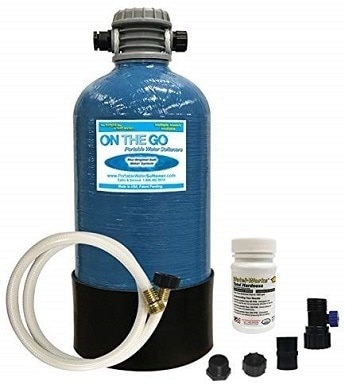
Able to supply 40% more soft water than other leading units, the OTG4 16,000-Grain Portable Water Softener from On The Go was our favorite overall. With 40 days and 1,600 gallons between regenerations, you’ll have far less upkeep with this softener than with other models. When it does need more salt, it’s going to take two full boxes to regenerate. This is more than most units, which makes sense since it can go longer between each fill-up. Luckily, it will take no tools to hook up or regenerate. Regeneration takes just 30 minutes and you’ll be back to clean, soft water for the whole vehicle. It also requires no electricity to run, which is why it’s perfect for RVs.
The On The Go OTG4-DBLSOFT-Portable 16,000 Grain RV is a bit more expensive than some of the other models we tested it against. For us, the additional capacity and longer time between upkeep make it worth the additional expense.
- Regenerates in just 30 minutes
- Provides 1,600 gallons between fills
- Supplies 40% more soft water than other units
- Requires no tools or electricity
- Requires two whole boxes of salt
2. Watts Water 10,000 Water Softener – Best Value
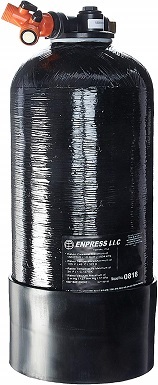
With flow rates of up to four gallons per minute, we think the Watts Water M7002 Flow-Pur RV-Pro water softener is the best RV water softener for the money. We loved being able to regenerate the system using common table salt without having to disconnect anything. This saved us time and frustration and is one of the traits that earned this softener our pick for best value. That said, our first one did end up cracking around the plastic at the head. Thankfully, it’s protected by a one-year warranty, so it was replaced without any issue. Our second one presented no problems and was a strong performer in every aspect. It’s affordably priced, and it’s also one of the lightest units, despite the impressive 10,000-grain capacity. Altogether, it’s one of the best performers and a great value.
- Affordably priced
- Up to 4GPM flow rates
- Very lightweight
- Can regenerate without unhooking it
- Plastic around the head cracked
3. On The Go 8,000 Grain RV Water Softener
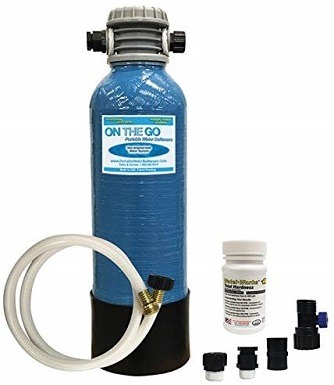
The little brother to the device that earned our top pick, the On The Go OTG40Std Soft-Portable 8,000-Grain Water Softener is a more compact version that’s a bit less convenient. It’s also a bit more affordable, which we certainly don’t mind. Thanks to the smaller design of this one, you’ll save more space and it can squeeze into almost anywhere. It doesn’t require any tools or electricity to run or regenerate, but it still has some drawbacks that kept it from earning our top recommendations. For instance, this 8,000-Grain model only lasts 20 days between regenerations, so you’ll be spending more time adding salt and rinsing. You also have to unhook it to recharge making it more of a hassle—something that’s exacerbated by the fact that you’ll be performing it twice as often.
In the end, it’s a great, compact, portable water softener for your RV, we just prefer the larger capacity of the 16,000-grain model.
- Affordably priced
- Compact space-saving design
- Requires no tools or electricity
- Only lasts 20 days between regenerations
- Takes a lot of work to recharge
4. Mobile-Soft-Water 16,000 RV Water Softener
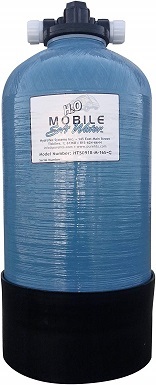
Larger capacity means regenerating less often, resulting in far less upkeep overall. The 16,000-grain capacity of the Mobile-Soft-Water Portable RV Water Softener is pretty impressive, especially when coupled with the five-gallon-per-minute flow rate. Compared to other portable water softeners with a similar capacity, this one is priced rather affordably. While we loved the capacity and the price, other flaws prevented the Mobile-Soft-Water softener from climbing to the top of our list.
The most important thing we’re looking for in a water softener is that it actually removes the excess minerals. Unfortunately, this device simply wasn’t effective at reducing the hardness in the water. Water from this device still left scale deposits that were easily visible when the water dried. The nylon fittings were another weak point. We managed to accidentally cross-thread them, which eventually caused the unit to leak. Though it is priced well and we like the large capacity, we still prefer something that’s going to continue working for a long time, and we’re willing to pay a bit more for the longevity.
- Affordable
- 5GPM flow rate
- Not effective at reducing water spots
- Nylon fittings cross-thread too easily
5. Triple Action Salt-Free Water Softener
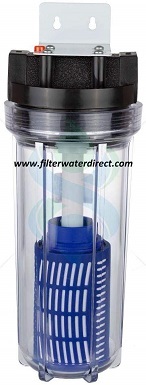
Despite being the most expensive option we tried, the Triple Action Poly Salt-Free Water Softener was also one of the least effective at softening the water. This is a salt-free softener, as the name implies, so you won’t be adding any sodium to your water. Moreover, a two-micron iron and bacteria filter is included, giving you a second level of defense against unwanted impurities in your water. This all sounds great, but it doesn’t perform how we had hoped.
We could see small Argonite crystals floating in our water, something that turned off many of our testers. Beyond this, we still had water spots on our dishes when everything dried, indicating that the water was not softened. We appreciated the excellent flow rate of 30 gallons per minute, but if the water isn’t softer than the water that goes in, then it’s simply not a good value at any price.
- Salt-free doesn’t add sodium to your water
- Includes 2-micron iron and bacterial filter
- Very expensive
- Can see the Argonite floating in the water
- Wasn’t effective at softening the water
- You may also like: Spring Water vs Purified Water: Which is Better for You?

Buyer’s Guide – How to Choose the Best Water Softener for Your RV
What benefits can you expect to see from adding a water softener to your RV? It’s a bit of an investment to get started with so you may be wondering if the value is worth it. Moreover, what should you look for in a water softener system to make sure it fits your lifestyle and fulfills your needs? What about maintenance and upkeep? Don’t worry, our buyer’s guide is going to clarify all of this to make sure you’re fully prepared and informed when you finish reading this article.
Benefits of Soft Water
So, why would you want to go through the trouble of adding a water softener to your RV to begin with? As it turns out, hard water has a lot of drawbacks that you can avoid by using a water softener to remove the excess minerals. Those minerals can do a lot of damage over time when they’re highly concentrated in the water. Plumbing and appliances can be destroyed by continual hard water use. Your RV is full of plumbing that is at risk, such as sinks, showers, toilets, pipes, and more. The damage caused by years of hard water use can make it harder to sell your RV and reduce its total value.
If you’ve struggled with hard water spots leftover on your dishes after washing or on your shower after using it, then you’ve seen some of the results of hard water. When the water dries up, only the harsh minerals are left behind. The calcium and magnesium built up in the water will be left as scale or hard water spots. It’s this same excess calcium and magnesium that a water softener will work to remove.
In America, more than 85% of homes are being fed with hard water. No matter where you go in your RV, it’s likely you’ll encounter water with more minerals than is ideal. Certain areas, such as the southwest, are known to have some of the hardest water in the country. In states like Arizona, New Mexico, and Texas especially, hard water can become a real issue.
Hard water also makes your soap less effective, so you’ll have to use more of it to get dishes, clothes, and even your skin clean. Worse, the minerals can even stain your clothing. As if that’s not enough, your hair and skin will also suffer. The extra minerals will dry you out and can leave you feeling itchy, ashy, and flaky.
By using a water softener, you can mitigate or eliminate all of these problems. Your soap will last longer, your clothes and dishes will be cleaner, your skin and hair will feel softer. More importantly, you’ll be preventing long-term damage from accumulating on your expensive investment.
How Do Water Softeners Work?
Now that we’ve covered some of the major benefits you can get from using soft water, let’s discuss how a water softener actually “softens” the hard water. As we mentioned, excess minerals in the water are what make it hard; particularly calcium and magnesium, but also lime and iron. Essentially, a water softener removes these minerals and leaves just the soft water behind. In reality, it’s a bit more complicated than that. The minerals aren’t simply removed, they’re replaced.
Most water softeners on the market are sodium-based. Within the device, resin beads hold positively charged ions that attract the magnesium and calcium. When they come in contact, the magnesium and calcium ions are replaced with sodium ions. Sodium doesn’t react poorly with soap, cause damage to plumbing, or leave scale when it dries, which is why it’s used to replace the excess minerals in hard water.
You may be wondering if this affects the taste of your water. In theory, it makes sense that adding salt to your water would make it taste salty. That’s not the case in reality since the amount of sodium being added is minuscule. You won’t be able to taste the sodium, but you will be able to taste the difference between the water with the hard minerals included and water with them removed.
Salt-Free Water Softeners
For those who don’t like the idea of adding sodium to their water, salt-free systems also exist for water softening. This may be preferable for those with hypertension or other health-related issues where excess salt intake is not desirable. While salt-based softeners remove the hard minerals by exchanging sodium ions in their stead, salt-free units simply neutralize the minerals. This prevents them from being able to bond together, effectively negating the drawbacks of hard water. Since the minerals are still present in the water you can still get them from drinking it, but they won’t be building up as scale deposits in your plumbing or on your fixtures and dishes.
Regeneration
RV water softeners typically use standard table salt to perform their ion-exchanges. Once the system runs out of sodium, new salt will need to be added to continue removing the hard minerals from the water. Luckily, these systems are built with regeneration in mind, so it’s a short and painless process that will get you back to soft water in about 30 minutes with most models. Some of our favorite softeners didn’t even need to be unhooked to regenerate, a feature we found to save time.
To regenerate, you’ll have to add table salt to your water softener. Most of them just use a single box of salt, but some of the higher-capacity models may need two boxes. Once you add the salt, the softener mixes it into a strong brine solution. This solution is then used to flush the calcium and magnesium from the resin balls, replacing them with sodium. After about 30 minutes, the remaining brine is rinsed out and only the recharged resin balls remain.
For most RV water softeners, 20 days is about the standard regeneration time, meaning every 20 days you’ll need to regenerate the system with salt to continue producing soft water. Some of the high-capacity systems can last much longer, able to provide soft water for up to 40 days or 1,600 gallons between regenerations.
How Long Will It Last?
When your water softener is being relied upon for all of your water needs, you’re going to be concerned with its overall lifespan. The softener itself can be expected to live for many years, providing tens of thousands of gallons of soft water. Of course, regeneration will need to be performed every 20-40 days, depending on the softener you purchased. How long can you continue regenerating any given device though? The resin balls inside of the softener have a lifespan of about 7-10 years, after which, they will need to be replaced. Thankfully, ion-exchange water softener resin is available on its own, so you can refill your water softener when it starts to lose effectiveness.
What to Look for in an RV Water Softener?
While all water softeners will remove the hard minerals to provide soft water, RV water softener systems have to do so in a very compact form. They differ greatly from traditional water softener systems in terms of size, price, capacity, and output. So, what should you look for in an RV-specific water softener system?
Capacity
The capacity of an RV water softener system is measured in grains. A 16,000-grain softener can remove 16,000 grains of sediments before it needs to be regenerated. The more grains it can hold, the longer it can last between regenerations. We generally prefer systems that require the least amount of input and upkeep possible. For this reason, we give preference to systems with the highest capacity, giving us the most time between maintenance. A 16,000-grain system will only need upkeep every 40 days, while an 8,000-grain system would need to be regenerated every 20 days.
Output
While an RV certainly won’t use as much water as a house would, you still want to make sure that you’ll have adequate output for all of your water uses. You don’t want to get a water softener that doesn’t produce enough flow to take a shower with! Generally, three to five gallons per minute should provide plenty of water to fuel all of your RV’s systems. Some systems manage incredible flow rates of up to 30-GPM, but this is overkill for an RV.
Size
It’s no secret that RVs aren’t the most spacious of living quarters. Generally, every inch of space is accounted for and put to good use, so you won’t want to sacrifice any of it to a cumbersome water-softening system. Luckily, manufacturers have been working to get these devices small and compact enough to fit inside a travel trailer or any vehicular living space. Be aware, units with a larger capacity will tend to be larger in size and vice versa. This means you’ll be making a tradeoff between the overall capacity and total size of your system. That said, even the larger capacity systems are not very bulky and should find a home tucked away somewhere in your RV without too much difficulty.

Conclusion
Having a water softener in your RV means you can have high-quality soft water everywhere you go, regardless of how hard the water is in any given area. To make sure you get the best one possible, we’ve tested as many of them as we could find. You’ve read the reviews comparing our five favorites. Before you make a decision, we’re going to quickly summarize our highest recommendations. The OTG4-DBLSOFT-Portable 16,000-Grain RV Water Softener from On The Go was the top performer and we suggest it for most people. The impressive capacity means it can go 40 days or 1,600 gallons between regenerations. When it’s time, regenerating takes just 30 minutes with two boxes of table salt. The device requires no tools or electricity and supplies 40% more soft water than competitors.
The Watts Water M7002 Flow-Pur RV-Pro 10,000-Grain Water Softener was a close second and our pick for best value. Conveniently, it can be regenerated without unhooking anything. It’s small and compact but still produces impressive flow rates of up to four gallons per minute. What’s best is you get all of this performance for a very affordable price.
Contents
